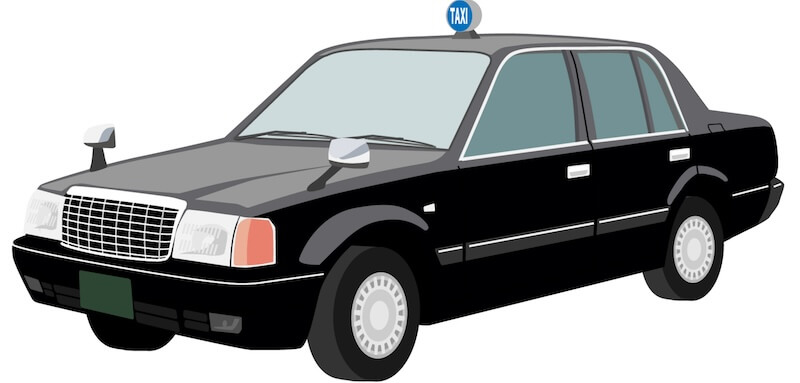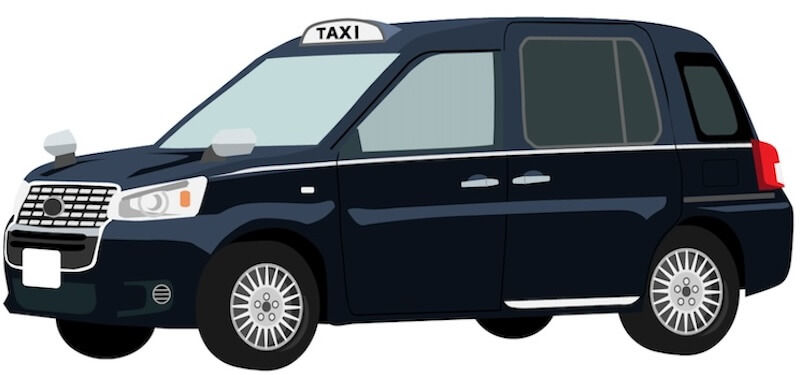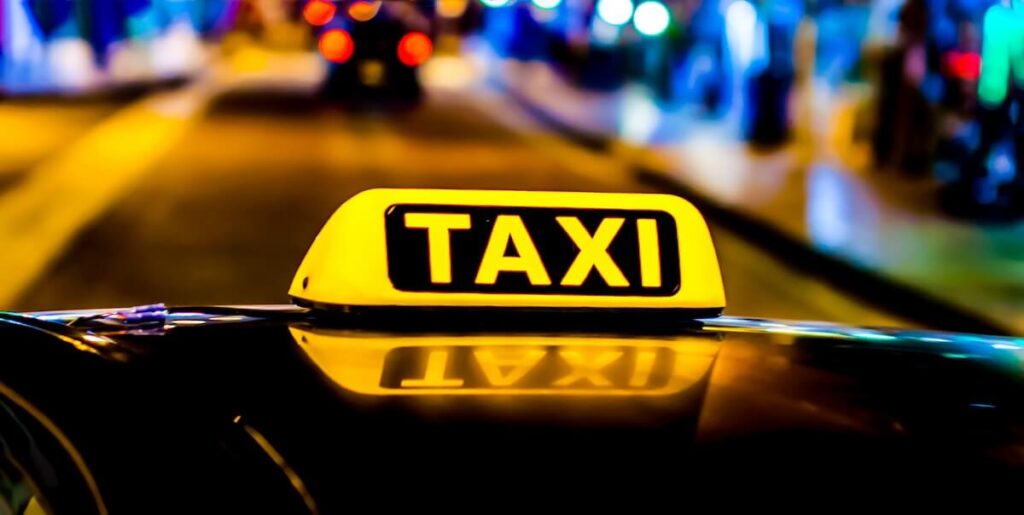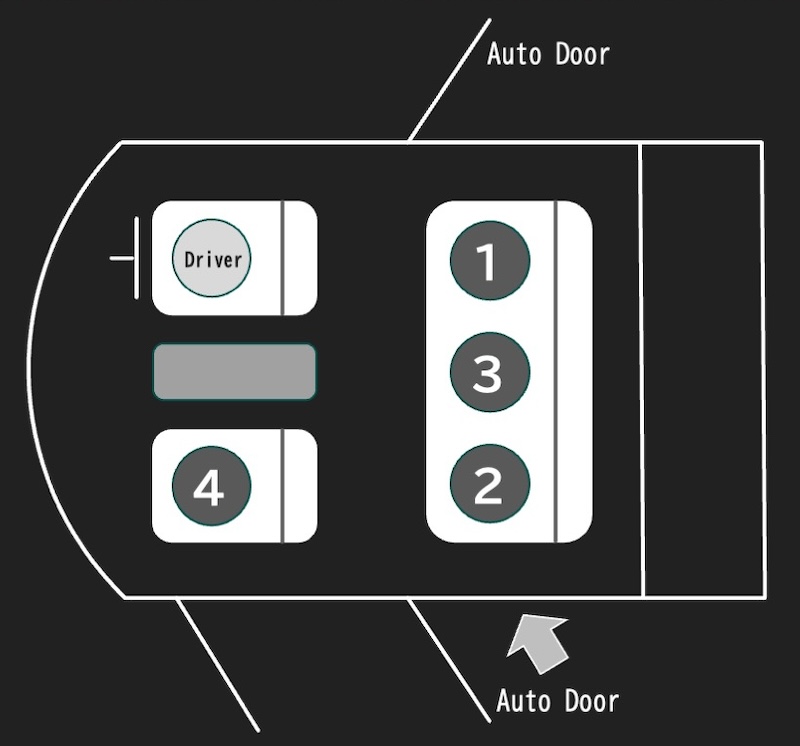Taxis are one of the public transportation options often used by tourists. Taxis in each country and region have different characteristics and have many differences in how they are used. Today, we would like to introduce you to Japanese taxis.
◆Taxi Vehicles
Taxis driving around the city have a “lamp” on their roofs.
– Sedan cars
The most common car for taxis in both Tokyo and the countryside are sedans. There is no set color. A taxi can accommodate up to four people (one person in the passenger seat and three people in the back seat) in general.

– JPN TAXI(ジャパンタクシー)
This is a new car model that debuted in the wake of the Tokyo Olympics. It is commonly seen in the Tokyo metropolitan area and three surrounding prefectures. Sliding doors make getting in and out of the car smoother. The wide legroom and high ceiling make the ride more comfortable, making it a favorite not only for taller people, but also for elderly people, people with children, and people traveling with a lot of luggage. Although it looks like a wagon taxi, it is a small car, and like a sedan, can only accommodate up to four passengers.

– Wagon taxi (minivan)
This is a larger vehicle that can accommodate up to five or six people. Wagon taxis are very convenient when you need to travel in a group or when you have a lot of luggage. As luggage space is limited, the taxi may not be able to accommodate the maximum number of passengers if you are traveling with a lot of luggage. It can be used by up to four adults and four suitcases in general. The HiAce model can accommodate up to nine adults, or six adults and six suitcases if you are traveling with a lot of luggage. You may think that you can’t use them unless you make a reservation outside of waiting lines at taxi stands at airports and train stations, but they are available throughout the city just like other taxis. If you raise your hand, you can hail a taxi.

◆Hailing a taxi
– Raise your hand and call the taxi
If you raise your hand on the side of the road, you can signal to a vacant taxi.

★How to tell if a taxi is vacant?
1) Look at the sign display:
the taxi is vacant if it says “空車/VACANT” or “割増” (increased fare)
“割増” will be displayed for vacant taxis when late-night fees apply.
“空車/VACANT and “割増” are often displayed in red.
On the other hand, “迎車” (pick-up), “回送” (out of service), “予約車” (reserved), “支払” (paying), etc. are often displayed in orange.
For visitors from overseas who cannot read kanji or cannot read the signs clearly from a distance, please use color to distinguish the signs.

2) Look at the lamps at night: If the lights are on, you can use the taxi.
Taxi lights are linked to the taximeter. When someone gets in the taxi, the taximeter will indicate “賃走” (in use)’ and the taxi’s lights will also turn off, so you can take the taxi if the lights are on.

※If you see a taxi’s light flashing red, please call 110. This is the “SOS” signal issued by the taxi driver.

– Hailing a taxi using taxi apps
The app “GO” is the most widely used taxi app in Japan. In Tokyo, “S.Ride” is also a convenient option. There are some cities where you can use Uber, which originated in the United States, and DiDi, originating from China, but the number of vehicles that can be used is very small and the area is quite limited.

When hailing a taxi using a taxi app, you generally need to register as a member, and a “pick-up fee” will be charged. If you choose to hail a taxi at a specified time instead of on the spot, a reservation fee will be charged.

– Calling a taxi
There are very few taxis outside of major cities and tourist areas. If you need to use a taxi from a taxi company that does use apps, the only option is to call the taxi company. As with app dispatch, a “pick-up fee”‘ and “reservation fee” will be charged. At restaurants and hotels, the facility may call a taxi for you.

– Waiting for a ride at a taxi stand
There are designated locations for getting a taxi in certain areas including airports, in front of stations, and downtown areas. Please wait in line at a designated taxi station.

◆Getting on a Taxi
– Seating order
If there are three or fewer people on board, all passengers generally sit in the back seat, and the fourth person sits in the passenger seat.

– Automatic doors
Most taxis have rear doors that operate automatically. There is no need to open or close the door yourself when getting on or off the taxi. The front door is not automatic. The person sitting in the passenger seat will need to open and close the door themselves.
– Seat belts
Those sitting in the passenger seat are required to wear a seat belt. For safety, passengers sitting in the back seat should wear their seat belts as well. On expressways, it is a requirement that passengers in the back seat use the seat belts.
◆Taxi Fare
– Metered taxi fares
Japanese taxi fares are metered, and in most cases, this is the only accepted fare.
The initial fare and distance-based fare differ depending on the region, but both use a combination of an hourly fare (10km/h or less) and a distance-based fare. Even if the route is the same, the fare may differ depending on the wait time at a red light, traffic congestion, etc.
In addition, late-night fares apply between 22:00 and 05:00, and are approximately 20% higher than regular fares.
– Payment method
Please have Japanese yen ready in cash when using a taxi.

In major cities and tourist destinations, payment methods other than cash such as credit cards, transportation IC cards, and QR code payments may be accepted. However, in rural areas, private taxis, and areas with poor network connection, cash may be the only payment option.

– Fixed-fare taxis
The use of fixed-price taxis is recommended for transportation to and from the airport. The fare is fixed, regardless of the route or traffic conditions, whether from your home or hotel to the airport or from the airport to your hotel or home. In addition to the “Airport Fixed-fare Taxi”, there is also the “Tokyo Disney Resort Fixed-fare Taxi”. The official hotels are also eligible for the fixed rate in addition to theme parks.

– Chartered taxi for sightseeing trips
In addition to metered fares and fixed-rate taxis, the use of ” sightseeing (chartered) taxis” is a great way to save money. You can use the taxi as your car for several hours to tour sightseeing spots or to visit guests, etc.
◆Business Areas and Refusal of Service
– Business area
In Japan, taxi operating areas are determined by law, so the taxi companies available differ depending on the location. When using a taxi, we recommend checking with the hotel of stay to find out which taxi companies are available and how to use them.
– Refusal of service
Generally, taxis in Japan do not refuse service. However, there are some exceptions in which a passenger may be turned down. If a passenger smokes, drinks, or acts violently in the vehicle and does not comply when stopped, if the passenger is carrying a dangerous object if the passenger is heavily intoxicated if there are hygiene issues and cleaning/deodorization is required after use, and if passengers who are severely ill do not have an accompanying passenger or display symptoms an infectious disease.
This has been an introduction to the basics of how to use a Japanese taxi.
In the second part, we will introduce trivia about Japanese taxis, such as local taxis and taxis with unique branding. If you are interested, please feel free to read the second part.